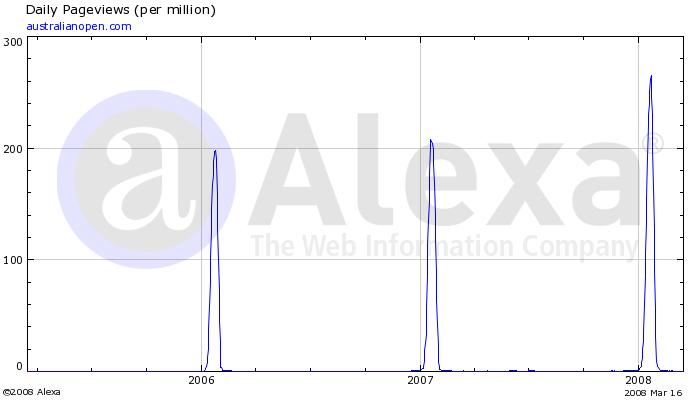
This is a graph of traffic to the website of the Australian Open tennis championship. As you can see, the traffic spikes in January every year and then all but disappears for the other 11 months of the year. It is also important to note that the height of the traffic spike is increasing year on year.
If the owners of this site want to be able to serve all the traffic at the top peak of the peak, they can spend a fortune on servers capable of handling that level of traffic but these servers will be almost entirely idle for eleven months of the year. The alternative is that the owners put the site on a cloud platform and dial up the resources associated with it, as and when needed. This is obviously a vastly more efficient option for the site owners. However, that doesn’t mean that cloud computing itself is Green or efficient.
For cloud computing to be efficient, the individual servers need to be doing more work than they would be doing if not in a cloud infrastructure. The main cloud providers include Amazon, Google, IBM and more recently, Microsoft. As far as I know, none of these companies are providing utilisation data per unit, so it is not possible to know just how efficient cloud computing actually is.
There is another consideration. There are a number of start-ups who say that they couldn’t have built their infrastructure if it wasn’t for cloud i.e. theirs is additional consumption which wouldn’t haven’t existed without the cloud. Does this newly facilitated consumption mean that cloud computing is less Green?
And without usage data from the cloud providers will we ever truly know if cloud computing is Green?

When you say a number of start-ups who ‘say’ then could not have built their infrastructure without the cloud, I think that most startups would have done it somehow, using the many shared hosting solutions out there.
I worked in an organistion where we were asked by the CIO to state how much energy was saved by using virtualisation (supposedly from CPU cycle saving), we gave an answer based on data quoted by the VM software vendor.
Ideally we would have had the opportunity to characterise the ‘real’ CPU energy usage against the virtual usage before making a dubious claim about how much energy we saved!
I think we could have saved alot more by dimensioning the server farm correctly rather than playing safe and deploying way too much capacity (IMO).
Discussion on Google Groups about virtualisation: http://is.gd/cfG7
General speaking, I like the topic. However, aren’t we building this Internet thing in part, to reduce friction, enable anytime/anywhere and real-time collaboration with anyone.
To me, learning more about the greenness of the cloud is kinda like studying the aerodynamic characteristics of a 8 cylinder diesel pickup truck. Or determining the carbon footprint of a website.
I really like the trend towards efficiency in personal computing. For example, oled monitors, solid state drives and new battery tech. I think we can get a bigger bang for our philosophical dollar by contemplating the role of the average worker in greening the cloud.
Or how about research correlating cloud computing with the greening of the planet?
Thanks for taking the time to write the post. I’ll share the analogy -it’s really useful.
twitter: Brent_Norris
If providers of cloud computing were encouraged to utilise renewable energy (and I don’t just mean “carbon trading”), then at least part of the problem would be reduced.
At Dharmafly, we spent quite a while hunting for decent renewable energy servers (the result of the hunt is here). However, we increasingly find that our web apps and APIs would benefit from a cloud setup.
But there aren’t any cloud platforms that run on renewable energy. Without it though, cloud computing can’t possibly deliver scalability and reliability in the deepest sense.
Well, in theory the cloud computing servers should be more highly utilized. I can imagine a stock trading website that is highly active from 9-5 EST, an entertainment/social networking site that is trafficked in the evening, and a market analysis company that runs batch analysis jobs all night long. If these three hypothetical companies scaled their fleets up and down during the day then the computers would be highly utilized at all times, but I’m sure things aren’t this ideal in practice. Although, with products like EC2, there is incentive to shut off unused instances.
Cloud companies providing SaaS should be able to get much higher utilization on their machines. If they are running a large, scale-out service, the demand is more predictable and the utilization can be adjusted with fine granularity when adding capacity.
As for the startups, I think John McBride makes a good point. It is likely a number of these startups would have been created anyway, just with higher fixed and upfront costs. This makes them less likely to succeed. If the startup does become self-sustaining I consider it a net win, even though they are increasing electricity use, because they are creating wealth.
Finally, last earth day I considered the efficiency and greenness of cloud computing and how my usage of S3 for backup compares to buying an extra hard disk. My numbers are probably not very accurate, but they shouldn’t be more than an order of magnitude off.